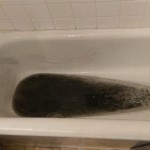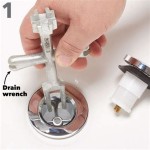Removing Rust Stains From Acrylic Bathtub Surrounds
Acrylic bathtub surrounds are a popular choice in modern bathrooms due to their durability, affordability, and aesthetic appeal. However, even with regular cleaning, these surfaces can be susceptible to rust stains. These unsightly marks, often appearing as orange or brown discoloration, are typically caused by iron-rich water, metal objects left in the tub, or even the fixture itself. Understanding the nature of rust and the appropriate removal techniques is critical to restoring the pristine condition of an acrylic bathtub surround without causing damage.
The composition of acrylic is a key factor in determining the cleaning methods that are safe and effective. Acrylic is a type of plastic known for its smooth, non-porous surface. This characteristic makes it relatively easy to clean, but it also makes it prone to scratching if abrasive cleaners or tools are used. Rust, on the other hand, is a chemical compound primarily composed of iron oxides, typically resulting from the reaction of iron with oxygen in the presence of water or moisture. This chemical bond can be stubborn, requiring specific cleaning agents to break down the rust without harming the acrylic surface.
Before embarking on any rust removal process, it is essential to identify the severity of the stain and assess the type of acrylic surface. Some acrylics are more sensitive to certain chemicals than others. A small, inconspicuous test area should always be cleaned first to ensure that the chosen method does not cause discoloration, etching, or other damage to the surround.
Identifying and Addressing the Source of the Rust
Before focusing solely on the removal of existing rust stains, it is crucial to identify and rectify the source of the rust. Failure to do so will inevitably lead to the recurrence of the problem, resulting in a perpetual cycle of cleaning. Common sources include dripping faucets, rusty metal objects left in the tub (such as shaving cream cans or razors), and even the water supply itself.
If a dripping faucet is the culprit, repairing or replacing the faucet is essential. Rust stains caused by metal objects should be addressed by removing the objects and preventing their future contact with the acrylic surface. Using rust-resistant shower caddies or storage solutions can significantly minimize this issue. If the water supply is high in iron content, a water softener or iron filter may be necessary to mitigate the problem at its source. Addressing the underlying cause will limit the formation of new rust stains and simplify future cleaning efforts.
The type of water source is also a factor. Well water, for example, is often higher in mineral content than municipal water supplies, increasing the likelihood of rust and other mineral stains. In such cases, understanding the specific mineral composition of the water can help inform the selection of appropriate cleaning products.
Gentle Cleaning Methods for Light Rust Stains
For light rust stains, a gentle approach is typically sufficient to remove the discoloration without risking damage to the acrylic surface. These methods prioritize non-abrasive cleaners and tools, focusing on dissolving the rust rather than scrubbing it away.
One effective option is a paste made from baking soda and water. Baking soda is a mild alkali that can help to loosen rust and lift it from the surface. To use this method, mix baking soda with enough water to create a thick paste. Apply the paste to the rust stain and allow it to sit for 15-20 minutes. Gently scrub the area with a soft cloth or sponge. Rinse thoroughly with clean water and dry with a clean towel.
Another gentle alternative is using a solution of vinegar and water. White vinegar is a mild acid that can dissolve rust and other mineral deposits. Mix equal parts white vinegar and water in a spray bottle. Spray the solution onto the rust stain and let it sit for 10-15 minutes. Wipe the area with a soft cloth or sponge, rinsing and drying as above. It is important to note that while vinegar is generally safe for acrylic, prolonged exposure or concentrated solutions could potentially dull the surface. Therefore, always dilute the vinegar and limit the contact time.
Mild dish soap can also be a helpful addition to these cleaning methods. Adding a few drops of dish soap to the baking soda paste or vinegar solution can enhance its cleaning power, helping to break down oily residues and lift the rust more effectively. The key is to ensure the dish soap is gentle and free of abrasive additives.
Stronger Cleaning Solutions for Stubborn Rust Stains
When gentle cleaning methods prove insufficient for removing stubborn rust stains, stronger solutions may be necessary. However, it is crucial to proceed with caution, prioritizing products specifically designed for acrylic surfaces and always testing in an inconspicuous area first.
Commercial rust removers formulated for bathroom surfaces are readily available. When selecting a product, carefully read the label to ensure it is safe for use on acrylic. Follow the manufacturer's instructions precisely, paying close attention to application time and safety precautions. Many of these products contain chemicals that can irritate the skin or eyes, so wearing gloves and eye protection is advisable.
Another option, albeit one that requires careful handling, is a lemon juice and salt mixture. Lemon juice contains citric acid, which is a natural rust remover. The salt acts as a mild abrasive, helping to scrub away the loosened rust. To use this method, cut a lemon in half and sprinkle salt generously onto the cut side. Rub the lemon directly onto the rust stain, applying gentle pressure. Allow the lemon juice and salt to sit on the stain for 10-15 minutes, then rinse thoroughly with clean water and dry. This method should be approached with caution, as excessive scrubbing or prolonged exposure to citric acid could potentially damage the acrylic if not used correctly.
In cases where rust stains are particularly severe or deeply embedded, a specialized rust removal gel may be required. These gels are designed to cling to vertical surfaces, allowing the cleaning agent to penetrate the rust for an extended period. Apply the gel according to the manufacturer's instructions, allowing the recommended dwell time before rinsing thoroughly. These gels often contain potent chemicals, so it is crucial to use them sparingly and with proper ventilation.
Regardless of the cleaning solution used, it is imperative to avoid abrasive cleaning tools such as steel wool, scouring pads, or stiff-bristled brushes. These tools can create scratches on the acrylic surface, making it more susceptible to future staining and dulling its appearance. Soft cloths, sponges, or microfiber cloths are the ideal choices for cleaning acrylic bathtub surrounds.

Clean With Me Removing Rust Stains From A Bathtub And Marble Best Cleaning Ever

Ask Me Anything Rust Stains He Washer Stained Concrete More Everyday Skate

Clean With Me Removing Rust Stains From A Bathtub And Marble Best Cleaning Ever

How Do You Get Rust Stains Out Of A Plastic Tub Hometalk

How To Remove Rust Stains In A Tub Without Chemicals Get Green Be Well

How Do I Clean A Rusty Bathtub Hometalk

How To Clean Acrylic Tubs And Shower Walls

Removing Soap Scum Orange Stains In Shower Surrounds

How To Remove Heavy Rust Stains From Your Bathtub Shower Toilet Simple Quick Great For Wells

Goof Off 22 Oz Bathroom Rust Stain Remover Spray Esx20005
Related Posts








